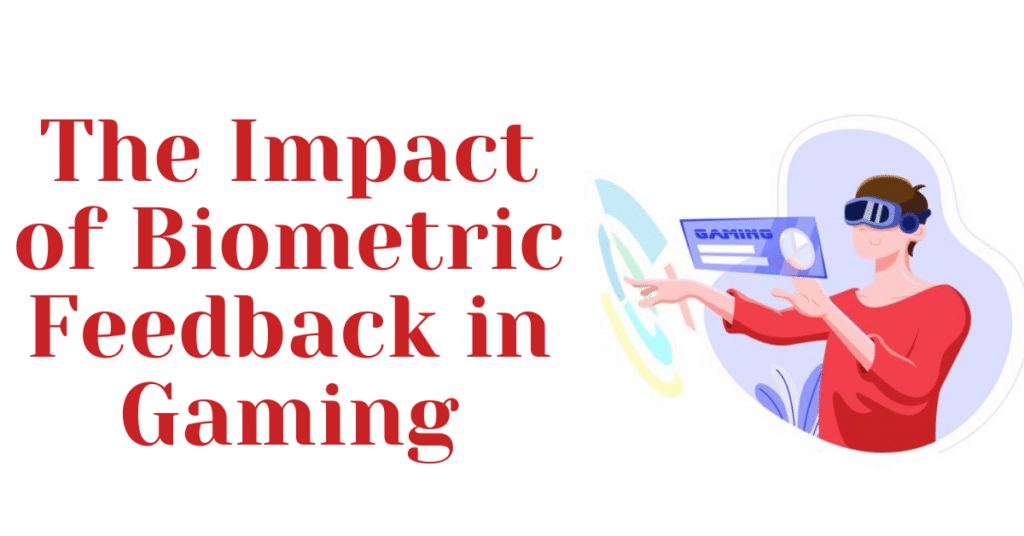
In the gaming biz, new technologies improve user experience. One of the most exciting recent innovation is biometric game feedback. Physiological data, e.g. heart rate, skin conductance and muscular tension) are fed back to a player’s emotional and physical status. Adding immersion and customisation this device may totally change the way gamers play games. Gaming as vehicle for biometric feedback and possible interactive entertainment uses are discussed in this article.Gaming Biometric Feedback is what.Gaming biometric feedback devices capture players’ physiological reactions as they are happening. Some examples are heart rate variability, skin temperature, perspiration, eye movement and brain activity. The data here is from heart rate monitors, EEG headbands, and fitness trackers.This data helps games respond in real time in an immersive way. A game can increase difficulty if a player is calm, or it may a stress relieving event if a player is stressed. Games are better fun and more dynamic.Immersive Feedback improves the Biometric Experience.One of biometric feedback’s biggest benefits is that it provides game immersion. Traditionally games deliver static experiences through the players mood or physical status. The game responds to the user in real time so the overall atmosphere becomes more living.Player Stress Adjustment for Game DifficultyMeasuring stress is possible using biometric sensors around players’ heart rates and skin conductance. The game may measure the difficulty down a notch or add a relaxing element such as: a peaceful place, or a break from action. But if the player is too casual the game can adjust the stakes to keep it interesting.Emotional Feedback (EFB) and Deep StorytellingEmotional data from biometric feedback games may be used to tell stories. When a game senses anxiety or fear (a racing heart rate or sweaty hands), it can breed action, suspense or drama into the experience by changing what the narrative might be. On the other hand, the game could create heavier and more comical scenes for the user if they are cheerful or relaxed or a more fitting plot could be given.Fotrward Progress in Game Physical InteractionBiometric input games in which actual body movement, such as muscle tension or body heat, determine how far to move or how high the challenge level increases. For VR and AR games more realistic interactions can be beneficial. The system will suggest a break or a somewhat easier assignment if the player becomes too fatigued or stressed in order to improve the player’s wellbeing and to prevent burnout.Biometric Feedback is used differently in different gaming genres.Horror GamesIn horror games, biometric feedback works out great. Measuring heart rates and perspiration levels may cause developers to anxious and stressed. Depending on their emotions, a game may even make players jump because of their heart rate scaling up or maybe it may instigate them. It gives us more specific and scary experience that reacts to user behavior.Fitness GamesFitness game love biometric feedback. That sort of biometric feedback could make something like “Ring Fit Adventure,” a video game that blends exercise with enjoyment, even better. Real time exercise intensity is changed based on the heart rate, body temperature and muscular tension of a player in fitness games to provide maximum results and minimum damage.RPGsBiometric feedback produced in RPGs could adapt the experience. When a player’s pulse rate goes up during a violent combat, the game may alter the story or stack problems. The game may seem more sensitive and unique to your experience if more challenging objectives or emotional challenges which forces a comfortable and confident player to their boundaries.Future of Gaming Biometric FeedbackIf biometric sensors continue to improve and become more cheap then we might see biometric feedback in gaming become mainstream. Future games may take advantage of biometric sensors inside of controllers, VR headsets, and wearable devices to provide players with real time interactions with their physical and emotional states.Using biometric sensors in more in depth player monitoring may give insights into player preferences, mood and areas for improvement.Colclusion:The use of biometric feedback can add fun to gaming allowing for a more personalized experience. Real time games might allow games to change according to players’ emotional and physical states and offer deep dynamic interactions that are simply not possible otherwise. Biometric data can help creators in horror games, fitness apps and RPGs to build more immersive and personalized experiences.